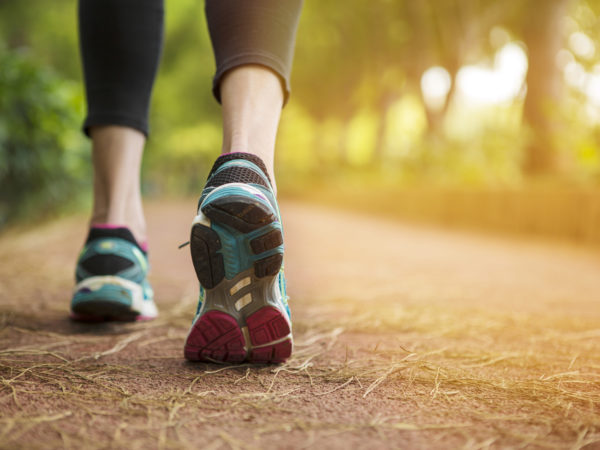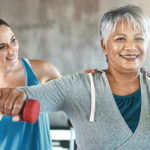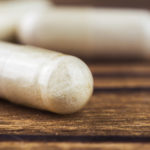Osteoporosis

What is osteoporosis?
Osteoporosis refers to a loss of bone mass causing bones to become more porous and fragile. Our skeletal frame is constantly being remodeled, with bone tissue being broken down and rebuilt on a regular basis. Bone density (the degree of mineralization of the bone matrix) usually increases until about the age of 30, but after that, it is more vulnerable to loss. Osteoporosis develops when more bone is lost than can be rebuilt. Eventually, bones become brittle and easily fractured. There are actually two different types of bone – both of which lose bone mass later in life, but at different times.
- Trabecular bone refers to the inner portion of bone that contains calcium in lattice crystal-like structures. The years from childhood through young adulthood are critical for depositing calcium in trabecular bone, which then provides a reserve of this mineral in later life. Trabecular bone is sensitive to several hormones, including estrogen, which control the amount of calcium deposited and withdrawn. The calcium in trabecular bone is used by the body when blood calcium levels are low. After age 30, a gradual loss in trabecular bone begins to occur.
- Cortical bone is the dense layer that forms the outer layer of bone. While both types of bone are crucial to bone strength and both contain calcium, cortical bone does not give up its reserves as readily as trabecular bone and does not begin to decline in mass until after about age 40.
What are the causes of osteoporosis?
- Genetics. Women are more at risk, but anyone of thin build and of Northern European or Asian descent is at higher risk. Studies of mothers and daughters have shown that heredity plays a role in bone density. Bone loss is more gradual in men, but once they reach age 70 their risk for osteoporosis increases significantly. Men in this age group are at increased risk for fractures, particularly if they are sedentary and have a diet low in calcium.
- Menopause. Particularly in those not taking hormone replacement therapy. estrogen plays an important role in maintaining bone mass. Once women reach menopause and estrogen levels decline, bone loss escalates. Rapid bone loss continues for about five years during and after menopause and can deplete three to four percent of total bone mass. This surge of bone loss eventually tapers off after a few years and soon equals the amount of bone loss in men of the same age. But the loss of bone minerals continues throughout the rest of a person’s life. About one out of every three postmenopausal women has osteoporosis to some degree with increased risk of fractures, particularly of the hip, vertebrae and wrists. Hip fractures are especially dangerous. About 20 percent of elderly women who undergo hip replacement surgery due to a fracture die of complications within one year. And half of those who survive will require full-time nursing care.
- Poor intake of calcium. Dietary calcium intake plays a vital role in bone mineralization during the growth years. Even after maximum bone mass has been achieved, calcium intake continues to be important to help slow down bone loss later in life. Dairy products are one of the best sources of calcium, but many people choose not to eat them or can’t tolerate them because of lactose intolerance or allergy. Other food sources of calcium are canned sardines, dark green vegetables like broccoli, collard greens and bok choy, as well as tofu and calcium-fortified juices and soy milk. However, a supplement is recommended to ensure you are getting enough.
- Lack of vitamin D. Vitamin D plays a pivotal role in allowing the body to absorb calcium. Vitamin D is synthesized naturally in the skin when it is exposed to sunlight. It is also available in fortified milk and cereals. However, many people do not produce enough vitamin D or get enough from food. Vitamin D deficiency is common among older people and those who are homebound or bed-ridden.
- Inactivity. Weight-bearing activities such as walking, jogging and weight training help to maintain bone density. A sedentary lifestyle promotes bone loss as well as muscle loss. Conversely, consistent use of muscles promotes the building of bone. Regular physical activity strengthens both muscles and bones, slows down bone loss and decreases the risk of injury from falls.
- Smoking. The relationship between bone loss and smoking has been confirmed by numerous studies.
- Excessive alcohol intake. People who drink alcohol to excess are more prone to fractures. This may be partially due to the diuretic effect of alcohol, which induces calcium loss through the urine. Alcohol can also decrease the absorption of calcium from the intestines and cause deficiencies in vitamin D and magnesium – both of which are important to bone health.
- High sodium intake. Several studies have demonstrated the harmful effects of high dietary sodium on bone integrity. Decreasing sodium intake can help reduce bone loss considerably.
- Coffee. Coffee consumption of more than two cups a day may contribute to accelerated bone loss.
- High consumption of animal protein. Some studies have shown that a diet high in animal protein promotes bone loss by leaching calcium from the bones, although the verdict is still out on this issue.
- A high acid-ash diet. Recent research has suggested that eating an acid-ash producing diet (high in animal protein and grains, low in vegetables and fruit) causes an increase in urinary excretion of calcium, leading to bone loss.
- Medications. Certain medications, such as steroids and anticonvulsants, may contribute to bone demineralization.
How is osteoporosis diagnosed?
The most accurate testing method to measure bone density and diagnose osteoporosis is the DEXA (Dual Energy X-ray Absorptiometry), which uses a computer to scan an image of the hip and spine. A more important measure is the FRAX score, which gives the risk of fracture. Less accurate screening methods are now available in pharmacies and at health fairs. X-rays, which were used in the past, are not sensitive. At least 25 percent of bone loss has to occur before osteoporosis can be reliably diagnosed from a routine X-ray.
What is the conventional treatment of osteoporosis?
There are a number of conventional prescription drugs for osteoporosis. The decision to use them should be made carefully, based on a person’s FRAX score and lifestyle. They have different benefits and risks, however. Evista (raloxifene) might be suitable for some women while Actonel (risedronate sodium) or Fosamax (alendronate sodium) would be better for others. Both Actonel and Fosamax seem to do a fairly good job of slowing menopausal bone loss. Fosamax’s effects can be seen as soon as three months after treatment begins and continue as long as you are on the drug. Unfortunately, this drug can cause severe digestive reactions including irritation, inflammation, and ulceration of the esophagus, all of which may cause chest pain, heartburn or pain with swallowing.
Actonel is newer than Fosamax and works in much the same way. Research shows that it reduces the risk of new vertebral fractures by 65 percent within one year of treatment. I have tended to recommend it over Fosamax because patients tell me that the side effects are milder. The most common include stomach upset, diarrhea, headache and joint pain that may disappear as the body adjusts to the medication.
Evista (raloxifene) is an entirely different type of drug, a selective estrogen receptor modifier (SERM). These agents seem to provide the benefits of estrogen replacement without increasing breast cancer risk. Because of the overlap in estrogen effects, drugs used to address breast cancer may also have influences on bone, and vice-versa. In fact, Evista appears to reduce breast cancer risk as well as protect against osteoporosis. Side effects include hot flashes and vaginal discharge, dryness, or itching. Tamoxifen, another drug used in breast cancer treatment, also protects against osteoporosis.
In 2009 The National Cancer Institute completed a five-year study comparing Evista to tamoxifen, called the “Study of Tamoxifen and Raloxifene (STAR),” The investigators found that both drugs were equally effective in reducing the risk of invasive breast cancer in postmenopausal women at high risk of the disease. Evista was reported as having a significantly lower risk of blood clots compared to tamoxifen, while having a slightly higher risk of non-invasive breast cancers. The conclusion was the overall benefit-risk profile was considered favorable for both medications depending on individual risk factors.
Fortunately, if you develop side effects to one of the available drugs, you can switch to another. Another drug receiving attention is strontium ranelate, a combination of the mineral strontium with ranelic acid. It has been licensed for sale in the UK and elsewhere in Europe for treatment of osteoporosis in postmenopausal women. A number of studies have shown that it can strengthen bone and reduce the risk of fractures, even among women 74 years of age or older when risks are highest. Strontium ranelate is not yet approved by the FDA for treatment or prevention of osteoporosis in the United States. It remains under study.
A final concern is that many women can’t tolerate the side effects of the popular drugs Fosamax, Actonel and Boniva, which are all varieties of bisphosphonates. Irritation of the stomach and esophagus is the most common reported problem, but some oral surgeons and dentists have begun to report a more serious concern in a sub-group of their patients: jaw necrosis, the death of the jawbone. This warrants further study.
What therapies does Dr. Weil recommend for osteoporosis?
- Eat plenty of vegetables and fruit. Potassium, magnesium, vitamin C and beta carotene (found in fruits and vegetables) have been associated with higher total bone mass. A diet rich in vegetables and fruit and moderate in animal protein and grains may minimize the acid-ash residue of the diet.
- Get enough calcium. This mineral is one of the primary constituents of bone, and adequate intakes are necessary for lifelong bone health. Choose high quality, organic dairy products such as yogurt and milk. Eat more sardines (with bones), dark green vegetables like collard greens, bok choy and broccoli, whole soy based products like tofu, and calcium-fortified soy milk and orange juice. Consider taking a calcium supplement if you are not eating at least three servings of dairy per day and/or calcium-fortified foods, if you are postmenopausal or if you have a family history of osteoporosis.
- Eat magnesium-rich foods every day, including spinach, tofu, almonds, broccoli and lentils. Pumpkin seeds and sunflower seeds are also good sources of magnesium.
- Eat vitamin K-rich foods every day. The best sources are green leafy vegetables (see the calcium-rich greens listed above), but most vegetables are good sources. Talk with your doctor about the effects of vitamin K if you are taking a blood-thinning medication.
- Make sure you get enough vitamin D. Have your vitamin level checked. I recommend supplementing with at least 2,000 IU daily for adults.
- Decrease your sodium intake. Avoid salty processed foods and fast food. Don’t salt your food before tasting it.
- Limit caffeine intake.
- Avoid alcohol or drink only in moderation.
- Increase weight-bearing activities, such as walking, weight training and calisthenics. Try to do at least 30 minutes of exercise most days of the week.
Originally posted October 2006. Updated February 2025.









